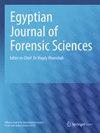Correlation of skeletal age by Greulich-Pyle atlas, physiological age by body development index, and dental age by London Atlas and modified Demirjian’s technique in children and adolescents of an Eastern Indian population
IF 1.3
Q3 MEDICINE, LEGAL
引用次数: 0
Abstract
Abstract Background Forensic age estimation using multiple maturity indicators necessitates investigation of correlation between various techniques. This study intended to compare and evaluate the correlation between skeletal age using Greulich-Pyle atlas, dental age by Acharya’s modification of Demirjian’s technique and London Atlas method of Tooth Development, and age estimated by body developmental index with chronological age. Orthopantomograms and left hand-wrist radiographs of one hundred seventy-four subjects (64 males and 70 females) in the age group of 8–20 years were evaluated by age estimation methods. Physical parameters including height, weight, biacromial breadth, and biliospinale breadth were measured. The data were entered in the SPSS software (Version 27.0). Comparison between age estimation methods was done using Student’s t -test for paired samples. Unpaired t -test was utilized for gender-wise comparison of age. Pearson’s correlation coefficient was calculated to assess correlation between the various methods. Results Significant mean differences were noted between the chronological age and all the age estimation methods when Greulich-Pyle atlas method (− 0.43), modified Demirjian’s method (− 0.31 ) , London Atlas Method (− 0.62), and body developmental index (− 0.51) were employed respectively. Inter-group comparison between all methods yielded no significant differences except for modified Demirjian’s method and London Atlas method (mean difference = 0.31). All the age estimation techniques showed strong correlation with chronological age; the best was provided by the Greulich-Pyle method ( r = 0.92). Conclusion All the assessed age estimation techniques show strong correlation with chronological age. Acharya’s modified Demirjian’s method (dental age) and Greulich-Pyle atlas method (skeletal age) showed good accuracy and strong correlation with chronological age, suggesting that these methods can be used simultaneously and/or interchangeably for age assessment in children and adolescents of Eastern Indian population.Greulich-Pyle地图集测定的骨骼年龄、身体发育指数测定的生理年龄、伦敦地图集测定的牙齿年龄和改进的Demirjian技术在东印度儿童和青少年中的相关性
背景利用多种成熟度指标进行法医年龄估计,需要考察各种技术之间的相关性。本研究旨在比较和评价Greulich-Pyle图谱测定的骨骼年龄、Acharya改良Demirjian技术和London牙齿发育图谱法测定的牙齿年龄以及身体发育指数随实足年龄测定的年龄之间的相关性。采用年龄估计方法对年龄在8 ~ 20岁的174例受试者(男64例,女70例)进行骨断层摄影和左腕x线片评价。测量身体参数包括身高、体重、双峰宽度和胆棘宽度。数据输入SPSS软件(27.0版)。年龄估计方法间的比较采用配对样本的Student’s t检验。年龄的性别比较采用非配对t检验。计算Pearson相关系数来评估各种方法之间的相关性。结果采用Greulich-Pyle地图集法(- 0.43)、改良Demirjian法(- 0.31)、伦敦地图集法(- 0.62)和身体发育指数(- 0.51)时,实足年龄与所有年龄估计方法的平均差异均有统计学意义。各组间比较,除改良Demirjian法和London Atlas法外,各组间差异均无统计学意义(平均差异为0.31)。所有年龄估计技术均与实足年龄有较强的相关性;以Greulich-Pyle法为最佳(r = 0.92)。结论所有年龄估计方法均与实足年龄有较强的相关性。Acharya改进的Demirjian法(牙齿年龄)和Greulich-Pyle地图集法(骨骼年龄)显示出良好的准确性和与实足年龄的强相关性,表明这两种方法可以同时和/或互换用于东印度人口儿童和青少年的年龄评估。
本文章由计算机程序翻译,如有差异,请以英文原文为准。
求助全文
约1分钟内获得全文
求助全文
来源期刊

Egyptian journal of forensic sciences
MEDICINE, LEGAL-
CiteScore
2.00
自引率
0.00%
发文量
51
审稿时长
17 weeks
期刊介绍:
Egyptian Journal of Forensic Sciences, the official publication of The International Association of Law and Forensic Sciences (IALFS), is an open access journal that publishes articles in the forensic sciences, pathology and clinical forensic medicine and its related specialities. The journal carries classic reviews, case studies, original research, hypotheses and learning points, offering critical analysis and scientific appraisal.
 求助内容:
求助内容: 应助结果提醒方式:
应助结果提醒方式:


